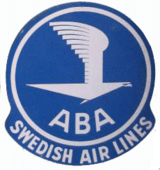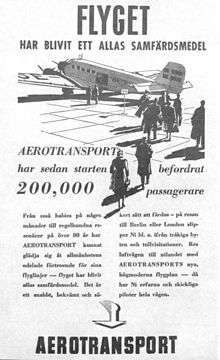AB Aerotransport
 | |
| Founded | 1924 |
|---|---|
| Commenced operations | June 2, 1924 |
| Ceased operations | October 1, 1950 |

AB Aerotransport (ABA) was a Swedish airline, that is today part of the SAS Group.
ABA was established in 1924 under the name Aktiebolaget Aerotransport by Carl and Adrian Florman. The first flight was on 2 June 1924 between Stockholm and Helsinki with a Junkers F.13 aircraft. The aircraft, registered as S-AAAC and later as SE-AAC, is now on display at the National Museum of Science and Technology in Stockholm. In 1925 the company started a route between Stockholm and Berlin in co-operation with Lufthansa and a mail route between Stockholm - Malmö - Amsterdam - London.
ABA was the first airline with three-engine passenger aircraft when in 1925, ABA bought three Swedish Junkers G.24 from AB Flygindustri. During the following years ABA used and bought several different aircraft (e.g. Junkers F.33, F.34, G.23, G.24). For the longer routes a Fokker F.XII was used.
In 1937 ABA became the second European operator of the Douglas DC-3 after KLM. This opened opportunities to fly "longer flights" for example to Moscow. In 1939 ABA started to mark their aircraft with Swedish Air Lines.
During World War II ABA tried to maintain their network, but in 1941 the route to Moscow was closed, and the route to Berlin ceased in 1945. During the war ABA had a courier flight between Stockholm and Scotland. After the German occupation of Europe ABA started new routes to Paris, Oslo and Prestwick.
In June 1948, after a Swedish report, the government-owned ABA and privately owned SILA were merged on a 50-50 basis, to form a new airline named ABA.
SILA had become the Swedish part of SAS in 1946, that was at that time only a co-operation between DDL in Denmark and DNL in Norway.
On October 1, 1950, representatives from the three airlines signed a consortium agreement where they appointed SAS to run the airline operations and the three national airlines only to be holding companies.
Fleet
| Manufacturer | Model | Quantity | Introduced | Retired |
|---|---|---|---|---|
| Junkers | F.13 | 10 | 1924 | 1938 |
| Junkers | G.24 | 5 | 1925 | 1932 |
| Junkers | W 33 | 2 | 1929 | 1931 |
| Junkers | Ju 52 | 8 | 1932 | 1948 |
| Fokker | F.XII | 1 | 1932 | 1946 |
| Northrop | Delta | 1 | 1934 | 1937 |
| Northrop | Gamma | 1 | 1934 | 1936 |
| Fokker | F.VII | 1 | 1934 | 1942 |
| Fokker | F.XXII | 1 | 1935 | 1936 |
| Junkers | W 34 | 2 | 1935 | 1940 |
| Douglas | DC-3 | 10 | 1937 | 1948 |
| Junkers | Ju 86 | 1 | 1938 | 1940 |
| Boeing | B-17 | 9 | 1944 | 1948 |
| Douglas | DC-4 | 3 | 1946 | 1948 |
Accidents and incidents
- August 31, 1932
- An AB Aerotransport Junkers G.24me (SE-AAE, Svealand) crashed at Tubbergen, Netherlands while attempting a forced landing following engine failure, killing the two crew.
- June 9, 1936
- An AB Aerotransport Fokker F.XXII (SE-ABA, Lappland) crashed while attempting an emergency landing at Bulltofta Airport following triple engine failure, killing one of 13 on board.
- August 27, 1943
- An AB Aerotransport Douglas DC-3-268 (SE-BAF, Gladan) crashed 70 km (43 mi) off Hirtstals, Denmark, killing all seven on board; the aircraft was probably shot down by a German fighter.
- October 22, 1943
- An AB Aerotransport Douglas DC-3-268 (SE-BAG, Gripen) was shot down by a Luftwaffe Junkers Ju 88; the pilot attempted a forced landing at sea, but the aircraft struck cliffs of Hallo Island, killing 13 of 15 on board.
- August 9, 1947
- An AB Aerotransport Douglas DC-3F (SE-BAY) overran the runway on landing at Bulltofta Airport, killing one of five on board.
- October 26, 1947
- AB Aerotransport Flight 1629, a Douglas DC-4-1009 (SE-BBG, Sunnan), struck Mount Hymettus while on approach to Hassani Airport, killing all 44 on board.